The Allocation of Water Resources in the Midstream of Heihe River for the “97 Water Diversion Scheme” and the “Three Red Lines”
Abstract
1. Introduction
2. Materials and Methods
2.1. Study Area
2.2. Data
2.3. Method
2.3.1. Water Resource Allocation Model in the Middle Reaches of the Heihe River
- Under the condition of satisfying the water demand guarantee rate of different types of users, reduce the over-exploitation of groundwater in the midstream.
2.3.2. Model Parameter Calibration
- Maximum allowable mining depth hg,D
- 2.
- Precipitation infiltration recharge coefficient α
- 3.
- Canal water use coefficient ηq and field water use coefficient ηt
- 4.
- Field infiltration recharge coefficient β
- 5.
- Supply coefficient of canal leakage mr
- 6.
- Water supply degree μ and conductivity coefficient Tg
- 7.
- Vertical permeability coefficient KV
- 8.
- Slope width product of diving flow and width-to-length ratio of diving current eg
- 9.
- Empirical constant of diving evaporation and limit depth
3. Results
3.1. Rationality Analysis of Water Resources Allocation in the Middle Reaches of Heihe River
3.1.1. The Middle Reaches of Heihe River Control Section Annual Runoff
3.1.2. Annual Average Groundwater Level in the Middle Reaches of the Heihe River Irrigation Area
3.2. Water Resources Allocation in the Middle Reaches of the Heihe River Without Considering the Total Water Consumption Index Control
3.3. Water Resources Allocation in the Middle Reaches of Heihe River Considering Control of Total Water Consumption Index
4. Discussion
4.1. Returning Agricultural Land to 1200 Km2
4.2. On the Premise of Maintaining the Farmland Area of 1200 Km2, Water-Saving Measures Were Implemented to Increase the Utilization Coefficient of Irrigation Water to 0.68
5. Conclusions
- The “97 Water Diversion Plan” and the “Three Red Lines” control the consumption and water use, respectively, in the middle reaches of the Heihe River. With improvements in water use level, and without exceeding the water use targets, water consumption still increased. This affected the ecological water of the lower reaches of the Heihe River. We constructed a water resource allocation model to satisfy the “97 Water Diversion Plan” and solve the shortage of ecological water of the lower reaches.
- Without considering the total water consumption index, even though the reasonable allocation of water resources, water intake, and consumption in the middle reaches of the Heihe River exceeded the water intake and consumption indicators. Considering water consumption in the middle reaches, and with the allocation of water resources, the water intake and consumption could be controlled within the indicators.
- After the rational allocation of water resources, it is necessary to control the farmland area to 1200 Km2 and implement water-saving measures, especially the control of farmland area is of great significance for the Heihe river resources.
Author Contributions
Funding
Institutional Review Board Statement
Informed Consent Statement
Data Availability Statement
Conflicts of Interest
References
- Ren, C.; Zhang, H. An Inexact Optimization Model for Crop Area Under Multiple Uncertainties. Int. J. Environ. Res. Public Health 2019, 16, 2610. [Google Scholar] [CrossRef]
- Kharrazi, A.; Akiyama, T.; Yu, Y.; Li, J. Evaluating the evolution of the Heihe River basin using the ecological network analysis: Efficiency, resilience, and implications for water resource management policy. Sci. Total. Environ. 2016, 572, 688–696. [Google Scholar] [CrossRef]
- Tsai, W.-P.; Chang, F.-J.; Chang, L.-C.; Herricks, E.E. AI techniques for optimizing multi-objective reservoir operation upon human and riverine ecosystem demands. J. Hydrol. 2015, 530, 634–644. [Google Scholar] [CrossRef]
- Wang, Y.; Li, Z.; Guo, S.; Zhang, F.; Guo, P. A risk-based fuzzy boundary interval two-stage stochastic water resources management programming approach under uncertainty. J. Hydrol. 2020, 582, 124553. [Google Scholar] [CrossRef]
- Liu, X.M.; Huang, G.H.; Wang, S.; Fan, Y.R. Water resources management under uncertainty: Factorial multi-stage stochastic program with chance constraints. Stoch. Environ. Res. Risk Assess. 2016, 30, 945–957. [Google Scholar] [CrossRef]
- Xu, J.; Tu, Y.; Zeng, Z. Bilevel Optimization of Regional Water Resources Allocation Problem under Fuzzy Random Environment. J. Water Resour. Plan. Manag. 2013, 139, 246–264. [Google Scholar] [CrossRef]
- Gong, X.; Zhang, H.; Ren, C.; Sun, D.; Yang, J. Optimization allocation of irrigation water resources based on crop water requirement under considering effective precipitation and uncertainty. Agric. Water Manag. 2020, 239, 106264. [Google Scholar] [CrossRef]
- Niu, G.; Li, Y.; Huang, G.H.; Liu, J.; Fan, Y.R. Crop planning and water resource allocation for sustainable development of an irrigation region in China under multiple uncertainties. Agric. Water Manag. 2016, 166, 53–69. [Google Scholar] [CrossRef]
- Yang, Y.E.; Son, K.; Hung, F.; Tidwell, V. Impact of climate change on adaptive management decisions in the face of water scarcity. J. Hydrol. 2020, 588, 125015. [Google Scholar] [CrossRef]
- Sullivan, A.; White, D.D.; Hanemann, M. Designing collaborative governance: Insights from the drought contingency planning process for the lower Colorado River basin. Environ. Sci. Policy 2019, 91, 39–49. [Google Scholar] [CrossRef]
- Li, M.; Guo, P.; Singh, V.P.; Yang, G. An uncertainty-based framework for agricultural water-land resources allocation and risk evaluation. Agric. Water Manag. 2016, 177, 10–23. [Google Scholar] [CrossRef]
- Singh, A. Simulation–optimization modeling for conjunctive water use management. Agric. Water Manag. 2014, 141, 23–29. [Google Scholar] [CrossRef]
- Micklin, P.P. Disiccation of the Aral Sea: A Water Management Disaster in the Soviet Union. Science 1988, 241, 1170–1176. [Google Scholar] [CrossRef] [PubMed]
- Feng, Q.; Endo, K.; Cheng, G. Towards sustainable development of the environmentally degraded arid rivers of China—A case study from Tarim River. Environ. Earth Sci. 2001, 41, 229–238. [Google Scholar] [CrossRef]
- Cheng, G.; Li, X.; Zhao, W.; Xu, Z.; Feng, Q.; Xiao, S.; Xiao, H. Integrated study of the water–ecosystem–economy in the Heihe River Basin. Natl. Sci. Rev. 2014, 1, 413–428. [Google Scholar] [CrossRef]
- RazaviToosi, S.L.; Samani, J.M.V. Evaluating water management strategies in watersheds by new hybrid Fuzzy Analytical Network Process (FANP) methods. J. Hydrol. 2016, 534, 364–376. [Google Scholar] [CrossRef]
- Beheim, E.; Rajwar, G.; Haigh, M.; Krecek, J. Integrated Watershed Management: Perspectives and Problems; Springer: Berlin, Germany, 2010. [Google Scholar]
- Raju, K.S.; Duckstein, L.; Arondel, C. Multicriterion Analysis for Sustainable Water Resources Planning: A Case Study in Spain. Water Resour. Manag. 2000, 14, 435–456. [Google Scholar] [CrossRef]
- Chen, Y.; Zhang, D.; Sun, Y.; Liu, X.; Wang, N.; Savenije, H.H. Water demand management: A case study of the Heihe River Basin in China. Phys. Chem. Earth Parts A/B/C 2005, 30, 408–419. [Google Scholar] [CrossRef]
- Zhang, K.; Kimball, J.S.; Nemani, R.R.; Running, S.W.; Hong, Y.; Gourley, J.J.; Yu, Z. Vegetation Greening and Climate Change Promote Multidecadal Rises of Global Land Evapotranspiration. Sci. Rep. 2015, 5, 15956. [Google Scholar] [CrossRef]
- Ren, C.; Yang, J.; Zhang, H. An inexact fractional programming model for irrigation water resources optimal allocation under multiple uncertainties. PLoS ONE 2019, 14, e0217783. [Google Scholar] [CrossRef]
- Guo, X.; Feng, Q.; Si, J.; Xi, H.; Zhao, Y.; Deo, R.C. Partitioning groundwater recharge sources in multiple aquifers system within a desert oasis environment: Implications for water resources management in endorheic basins. J. Hydrol. 2019, 579, 124212. [Google Scholar] [CrossRef]
- Wallace, J.S.; Gregory, P.J. Water resources and their use in food production systems. Aquat. Sci. 2002, 64, 363–375. [Google Scholar] [CrossRef]
- Xu, Y.; Qin, X. Agricultural effluent control under uncertainty: An inexact double-sided fuzzy chance-constrained model. Adv. Water Resour. 2010, 33, 997–1014. [Google Scholar] [CrossRef]
- Maqsood, I.; Huang, G.H.; Yeomans, J.S. An interval-parameter fuzzy two-stage stochastic program for water resources management under uncertainty. Eur. J. Oper. Res. 2005, 167, 208–225. [Google Scholar] [CrossRef]
- Steward, D.R.; Allen, A.J. Peak groundwater depletion in the High Plains Aquifer, projections from 1930 to 2110. Agric. Water Manag. 2016, 170, 36–48. [Google Scholar] [CrossRef]
- Fan, Y.; Huang, G.; Guo, P.; Yang, A. Inexact two-stage stochastic partial programming: Application to water resources management under uncertainty. Stoch. Environ. Res. Risk Assess. 2012, 26, 281–293. [Google Scholar] [CrossRef]
- Yang, G.; Guo, P.; Huo, L.; Ren, C. Optimization of the irrigation water resources for Shijin irrigation district in north China. Agric. Water Manag. 2015, 158, 82–98. [Google Scholar] [CrossRef]
- Jiang, L.; Jian, S.; Mo, L.; Songhao, S.; Xiaomin, S.; Jian, X.; Adeloye, J. Optimization of irrigation scheduling for spring wheat based on simulation-optimization model under uncertainty. Agric. Water Manag. 2018, 208, 245–260. [Google Scholar]
- Safavi, H.R.; Falsafioun, M. Conjunctive Use of Surface Water and Groundwater Resources under Deficit Irrigation. J. Irrig. Drain. Eng. 2017, 143, 05016012. [Google Scholar] [CrossRef]
- Zeinali, M.; Azari, A.; Heidari, M.M. Multiobjective Optimization for Water Resource Management in Low-Flow Areas Based on a Coupled Surface Water—Groundwater Model. J. Water Resour. Plan. Manag. 2020, 146, 04020020. [Google Scholar] [CrossRef]
- Yang, C.-C.; Chang, L.-C.; Chen, C.-S.; Yeh, M.-S. Multi-objective Planning for Conjunctive Use of Surface and Subsurface Water Using Genetic Algorithm and Dynamics Programming. Water Resour. Manag. 2008, 23, 417–437. [Google Scholar] [CrossRef]
- Li, Y.-P.; Huang, G.-H.; Nie, S.-L. An interval-parameter multi-stage stochastic programming model for water resources management under uncertainty. Adv. Water Resour. 2006, 29, 776–789. [Google Scholar] [CrossRef]
- Li, Y.-P.; Huang, G.-H. Interval-parameter Two-stage Stochastic Nonlinear Programming for Water Resources Management under. Uncertain. Water Resour. Manag. 2008, 22, 681–698. [Google Scholar] [CrossRef]
- Ji, L.; Sun, P.; Ma, Q.; Jiang, N.; Huang, G.-H.; Xie, Y.-L. Inexact Two-Stage Stochastic Programming for Water Resources Allocation under Considering Demand Uncertainties and Response—A Case Study of Tianjin, China. Water 2017, 9, 414. [Google Scholar] [CrossRef]
- Pahl-Wostl, C. The implications of complexity for integrated resources management. Environ. Model. Softw. 2007, 22, 561–569. [Google Scholar] [CrossRef]
- Zhang, C.; Zhang, F.; Guo, S.; Liu, X.; Guo, P. Inexact nonlinear improved fuzzy chance-constrained programming model for irrigation water management under uncertainty. J. Hydrol. 2018, 556, 397–408. [Google Scholar] [CrossRef]
- Zhang, W.; Nie, Z.; Liu, S.; Wang, J. Threshold of influence of water resources in the Heihe River valley, northwestern Gansu, China on the ecological environment variation of the lower reaches. Geol. Bull. China 2006, 25, 244–250. [Google Scholar]
- Shen, Q.; Gao, G.; Fu, B.; Lü, Y. Soil water content variations and hydrological relations of the cropland-treebelt-desert land use pattern in an oasis-desert ecotone of the Heihe River Basin, China. Catena 2014, 123, 52–61. [Google Scholar] [CrossRef]
- Shen, Q.; Ma, Y. Did water diversion projects lead to sustainable ecological restoration in arid endorheic basins? Lessons from long-term changes of multiple ecosystem indicators in the lower Heihe River Basin. Sci. Total. Environ. 2020, 701, 134785. [Google Scholar] [CrossRef]
- Minghong, T.; Luqian, Z. Increase in economic efficiency of water use caused by crop structure adjustment in arid areas. J. Environ. Manag. 2019, 230, 386–391. [Google Scholar]
- Yuyao, C.; Niu, J.; Kang, S.; Zhang, X. Effects of irrigation on water and energy balances in the Heihe River basin using VIC model under different irrigation scenarios. Sci. Total. Environ. 2018, 645, 1183–1193. [Google Scholar]
- Jiang, X.; Liu, C. The Response of Vegetation to Water Transport in the Lower Reaches of the Heihe River. Acta Geogr. Sin. 2009, 64, 791–797. [Google Scholar]
- Zhao, M.; Jiang, X.; Huang, Q.; Dong, G. Rationality Analysis of the Heihe River ‘97’ Water Diversion Scheme under Changing Environment. Tecnología y Ciencias del Agua 2019, 10, 66–87. [Google Scholar] [CrossRef]
- He, F.; Zhu, Y.; Jiang, S. An exploration of China’s practices in water conservation and water resources management. Water Conserv. Wastewater Treat. BRICS Nations 2020, 269–284. [Google Scholar] [CrossRef]
- Lu, Z.; Tang, D.; Zheng, B.; Zhu, C. Post-evaluation of the ecological impact of water diversion and recent management in the downstream Heihe River. Acta Entiae Circumstantiae 2011, 31, 1556–1561. [Google Scholar]
- Hu, L.; Xu, Z.; Huang, W. Development of a river-groundwater interaction model and its application to a catchment in Northwestern China. J. Hydrol. 2016, 543, 483–500. [Google Scholar] [CrossRef]
- Yi, J.; Zhao, Y.; Shao, M.; Li, H.; Jiang, R.; Hill, R.L.; Si, B. Hydrological processes and eco-hydrological effects of farmland–forest–desert transition zone in the middle reaches of Heihe River Basin, Gansu, China. J. Hydrol. 2015, 529, 1690–1700. [Google Scholar] [CrossRef]
- Chen, Y.; Wang, S.; Ren, Z.; Huang, J.; Wang, X.; Liu, S.; Deng, H.; Ling, W. Increased evapotranspiration from land cover changes intensified water crisis in an arid river basin in northwest China. J. Hydrol. 2019, 574, 383–397. [Google Scholar] [CrossRef]
- Ge, Y.; Li, X.; Huang, C.; Nan, Z. A Decision Support System for irrigation water allocation along the middle reaches of the Heihe River Basin, Northwest China. Environ. Model. Softw. 2013, 47, 182–192. [Google Scholar] [CrossRef]
- Yali, Z.; Yiya, L.; Qing, Z.; Feng, W. Optimal water allocation scheme based on trade-offs between economic and ecological water demands in the Heihe River Basin of Northwest China. Sci. Total Environ. 2020, 703, 134958. [Google Scholar]
- Li, M.; Guo, P.; Zhang, L.; Zhao, J. Multi-dimensional critical regulation control modes and water optimal allocation for irrigation system in the middle reaches of Heihe River basin, China. Ecol. Eng. 2015, 76, 166–177. [Google Scholar] [CrossRef]
- Pan, Q.; Xia, S.; Guo, S.S. Irrigation water optimal allocation for two-level canals based on canal water transfer simulation and soil water balance simulation. J. China Agric. Univ. 2020, 25, 157–168. [Google Scholar]
- Wang, Y.; Guo, P. Water-consumption structure optimization in oasis of middle reaches of Heihe River basin based on multi-objective optimization model. Trans. Chin. Soc. Agric. Mach. 2020, 51, 299–307. [Google Scholar]
- Zhang, Y.; Chen, M. Study on the Correction and adjustment scheme of Heihe water Distribution curve. Water Conserv. Constr. Manag. 2008, 28, 76, 79–80. [Google Scholar]
- Chang, J.; Niu, Z.; Wang, Q. Analysis on gross index of water resources development and utilization limited by control red line in gansu province. Yellow River 2012, 34, 72–73, 76. [Google Scholar]
- Wu, B. Discussion on the control strategy of total water supply in Zhangye City. Agric. Sci. Technol. Inf. 2016, 4, 134. [Google Scholar]
- Gao, Y.; Chen, G.; Liu, W. Modification of the soil characteristic parameters in Heihe River basin and effects on simulated atmospheric elements. Plateau Meteorol. 2007, 26, 958–966. [Google Scholar]
- Luo, Y.; Mao, Y.; Peng, S. Modified Aver’yanov’s phreatic evaporation equations under crop growing. Trans. Chin. Soc. Agric. Eng. 2013, 29, 102–109. [Google Scholar]
- Wang, S.; Xie, J.; Wang, N. Modified particle swarm optimization algorithm and its application in optimal operation of hydropower station reservoir. J. Hydroelectr. Eng. 2008, 27, 12–15, 21. [Google Scholar]
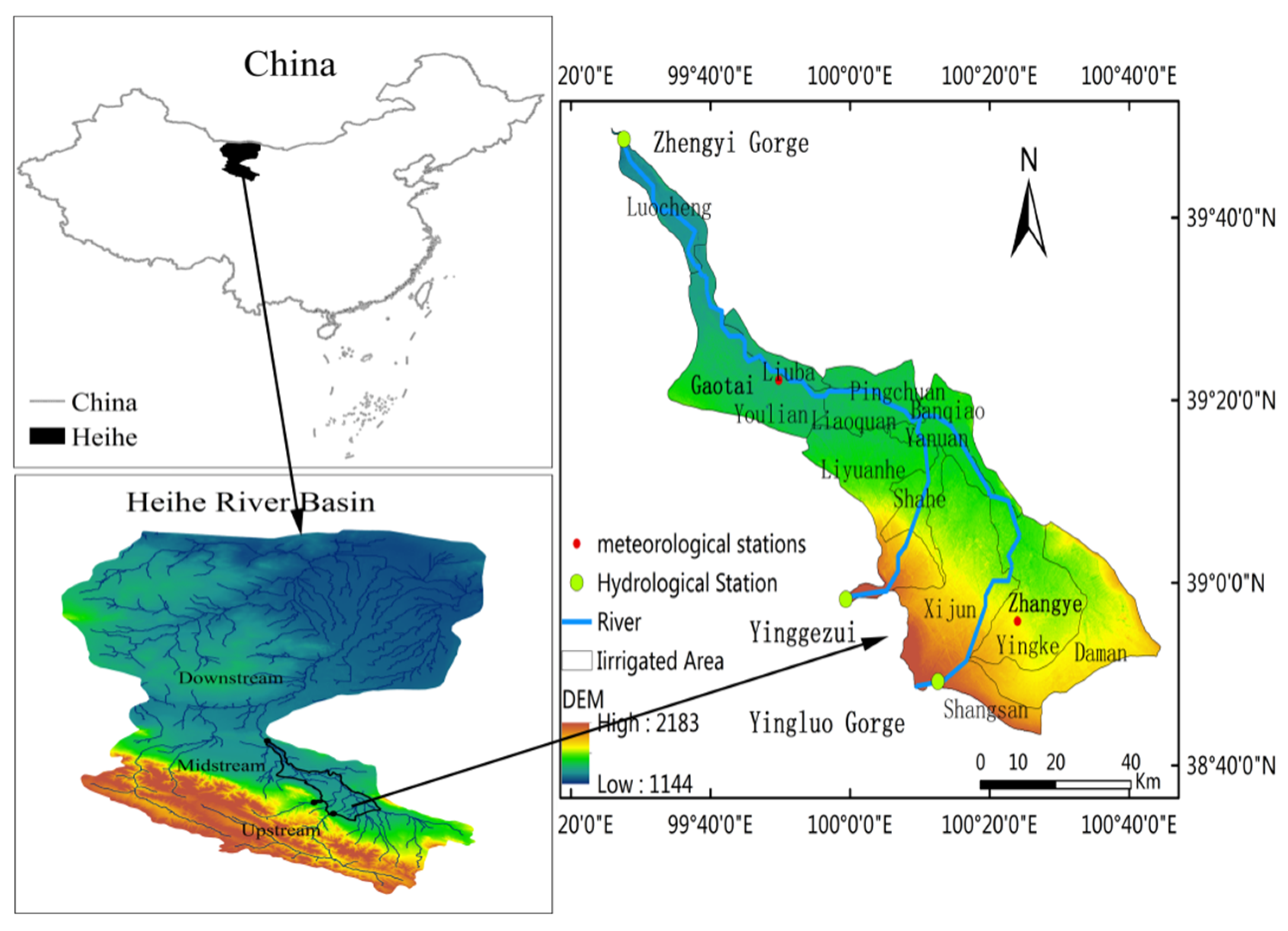

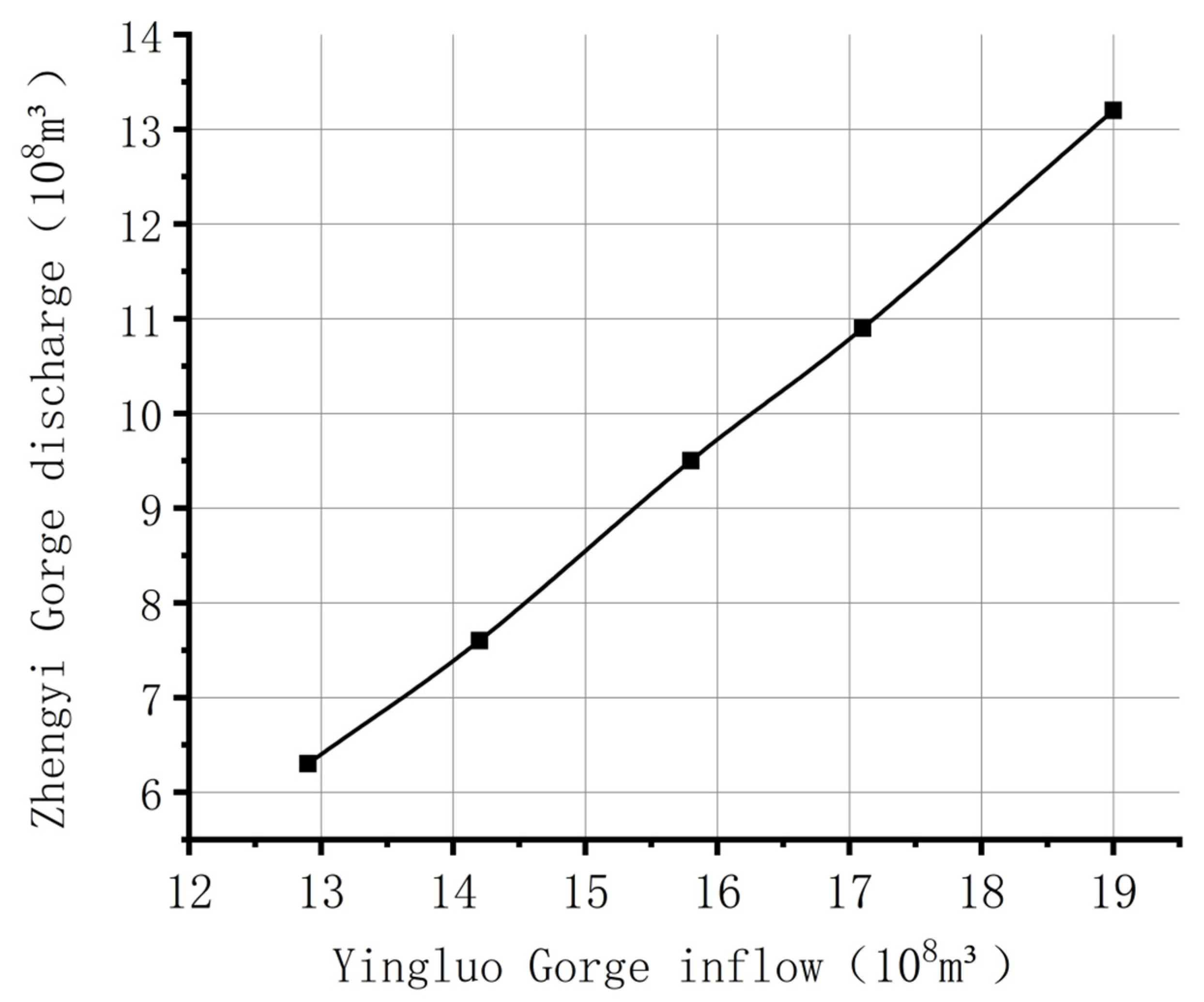
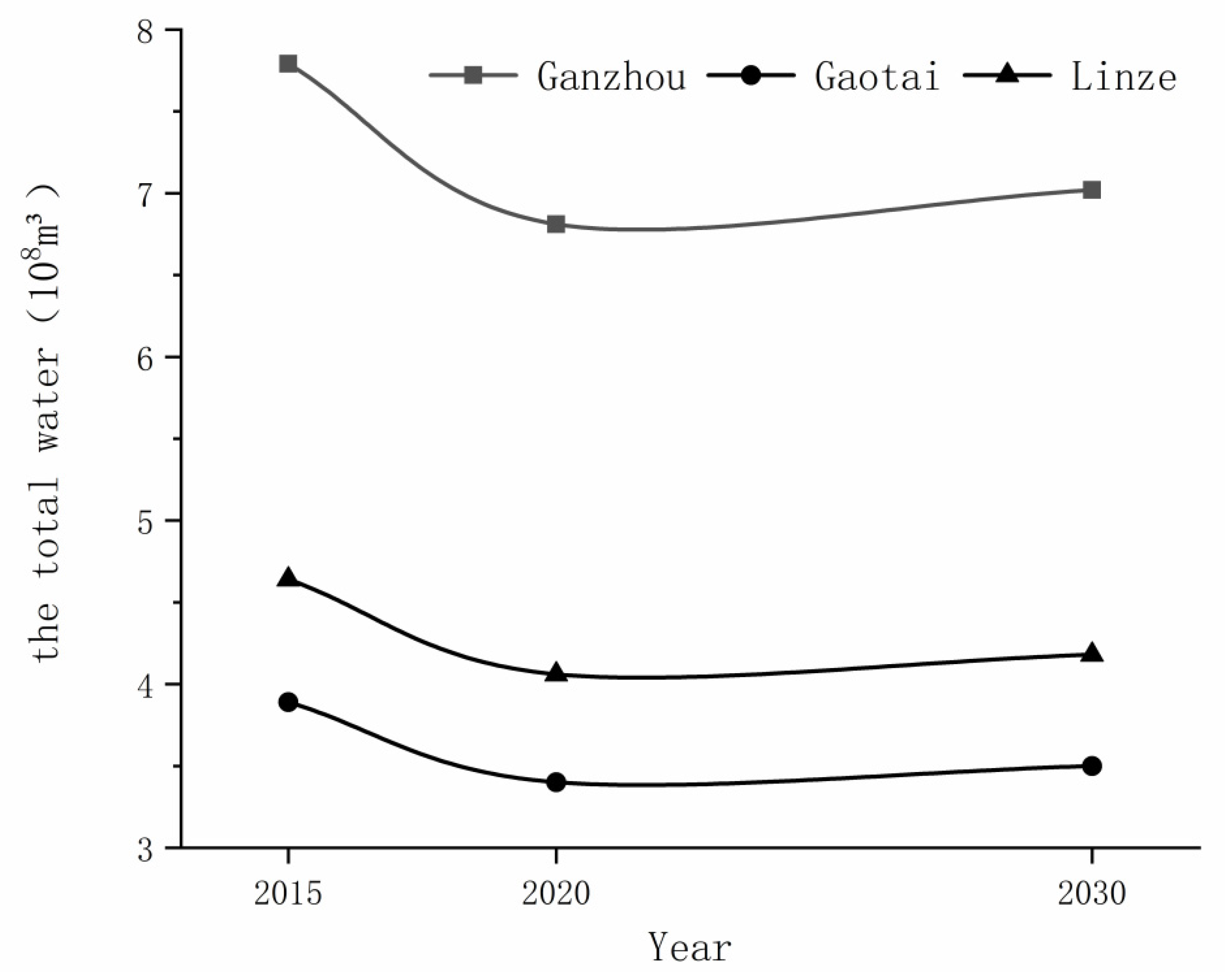
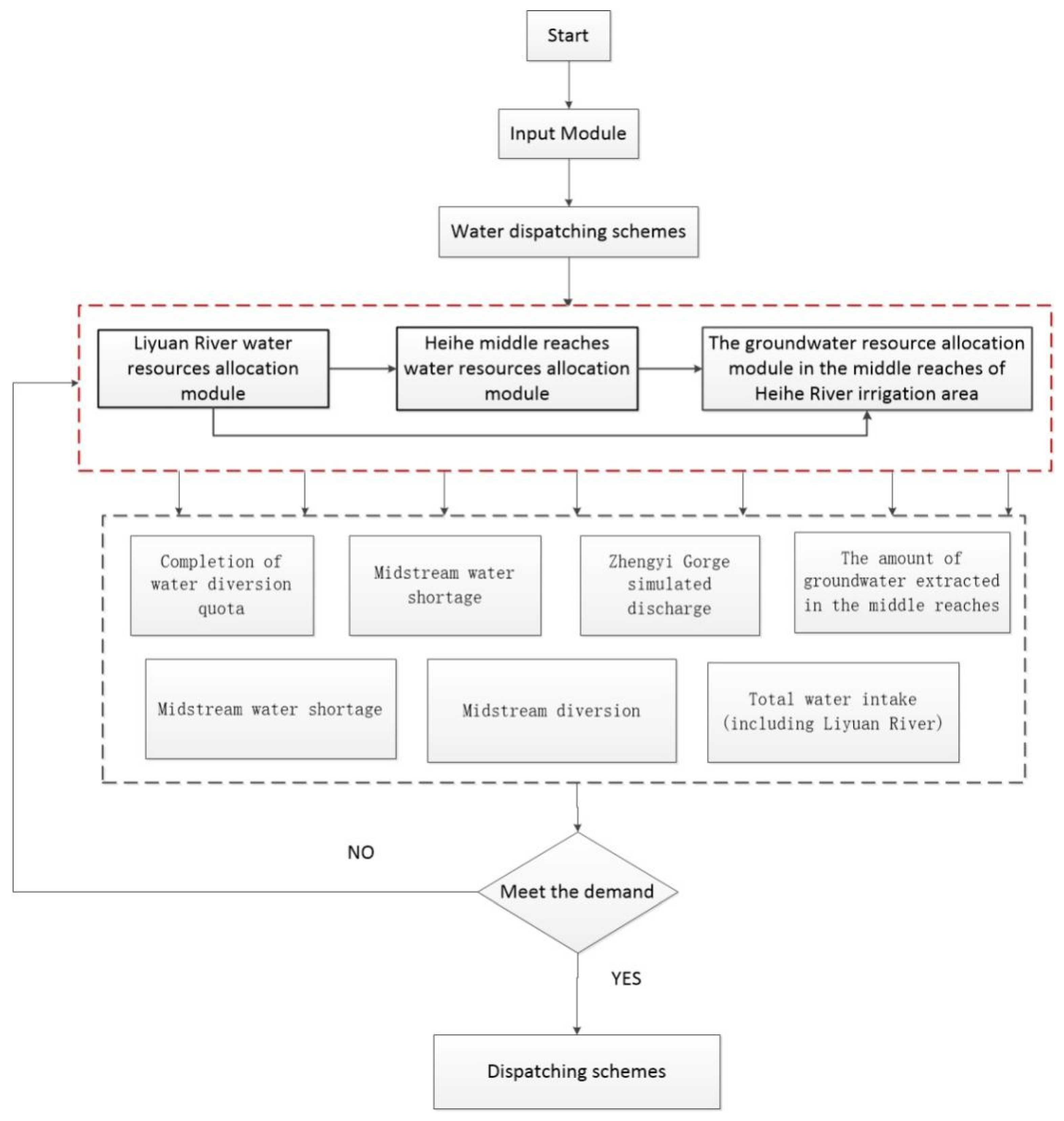
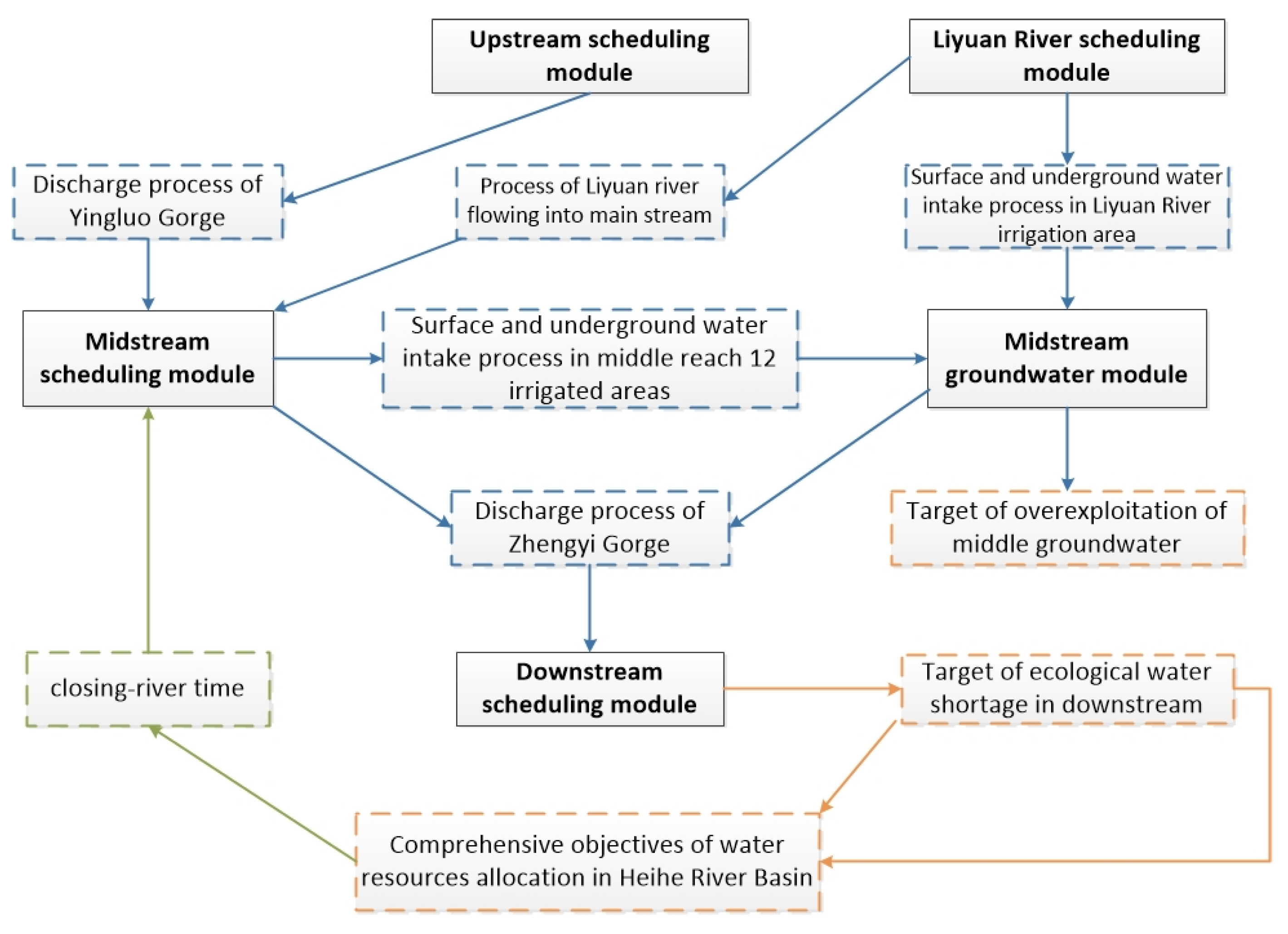
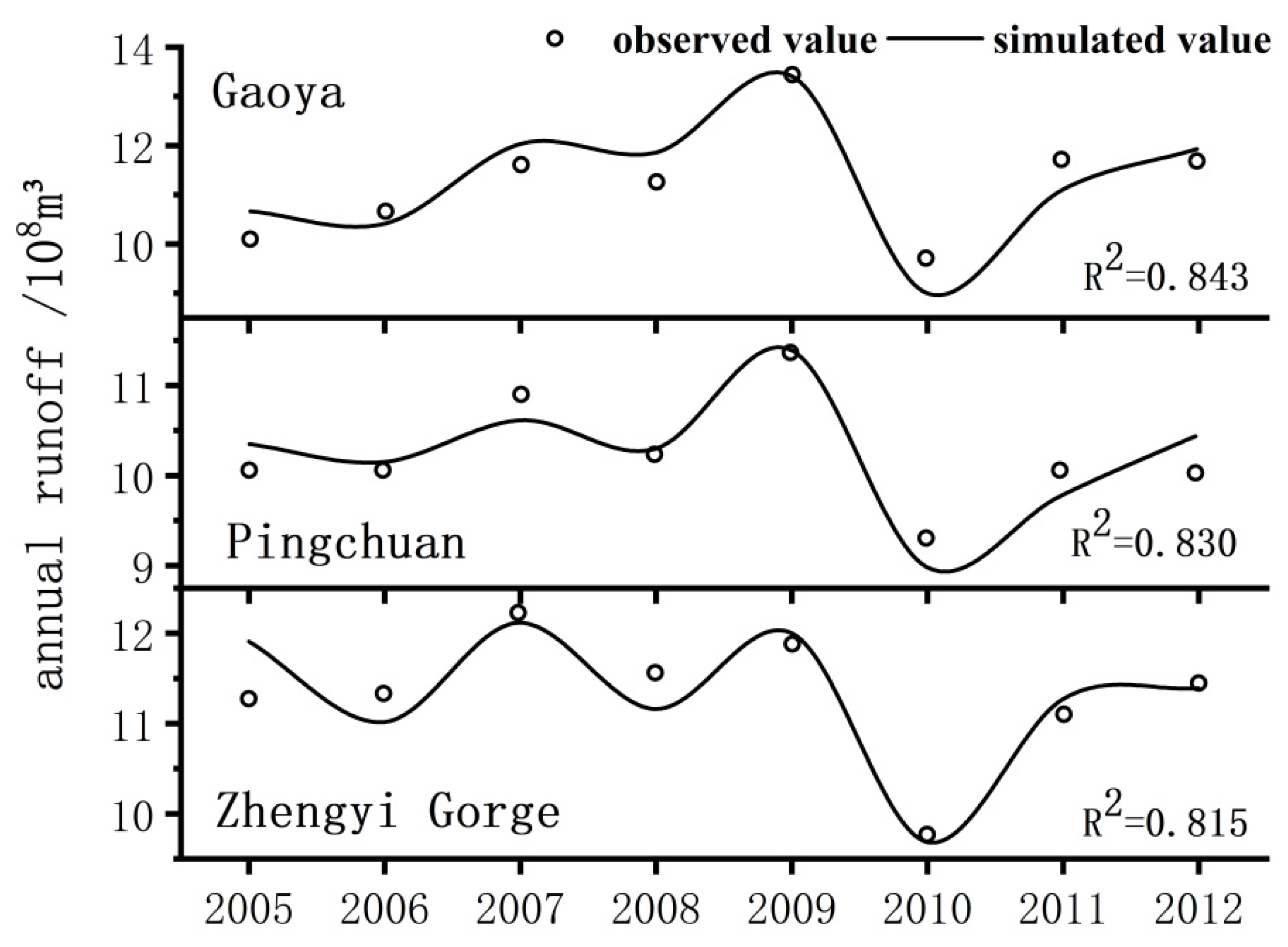
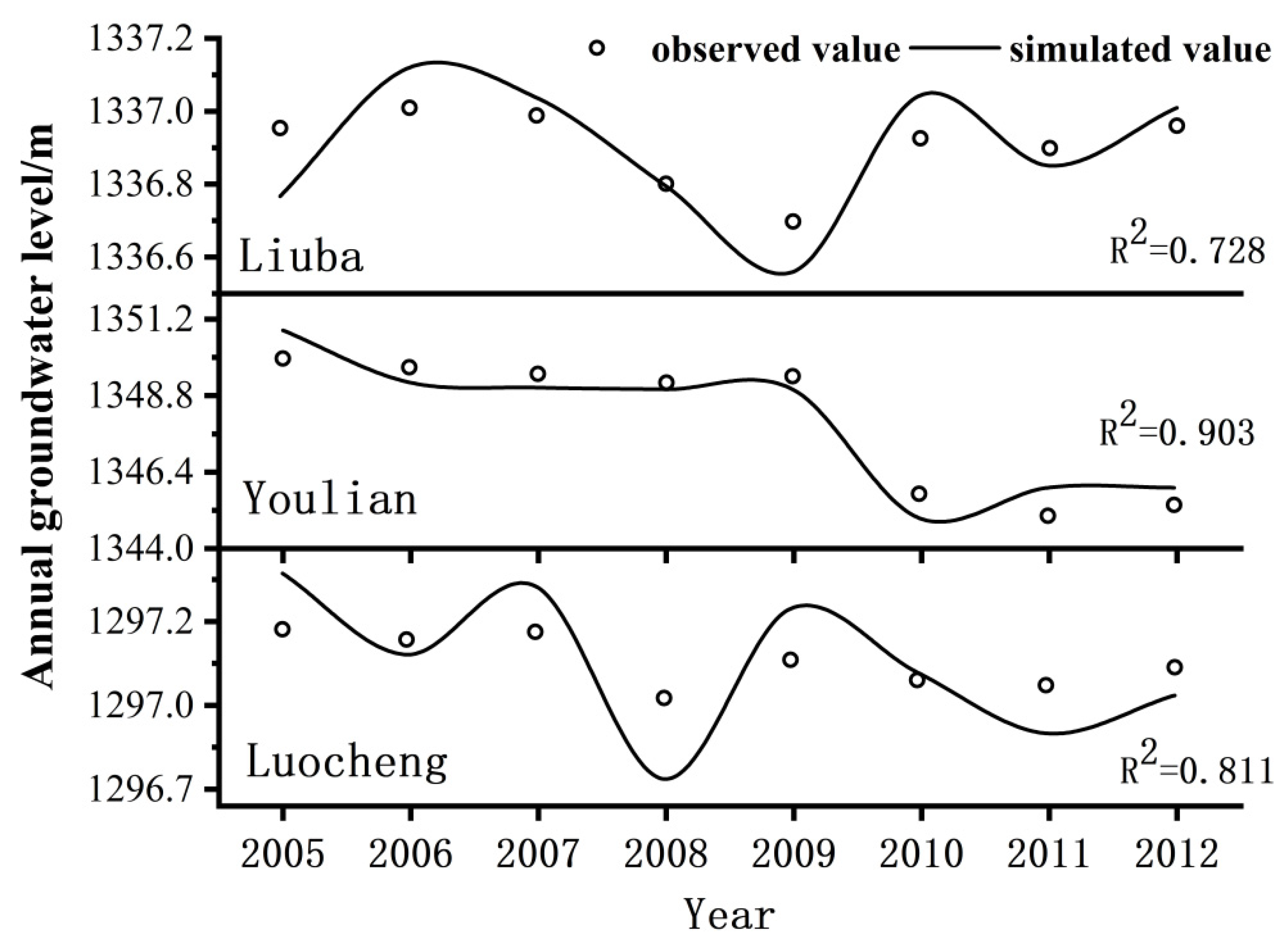

| Irrigated Area | (m) | α | ηq1 | ηt1 | β | mr |
|---|---|---|---|---|---|---|
| Shangsan | 154.6 | 0.10 | 0.52 | 0.92 | 0.29 | 0.40 |
| Daman | 20.1 | 0.12 | 0.58 | 0.92 | 0.40 | 0.44 |
| Yingke | 16.3 | 0.13 | 0.58 | 0.92 | 0.41 | 0.47 |
| Xijun | 10.5 | 0.16 | 0.58 | 0.92 | 0.44 | 0.52 |
| Liyuan river | 2.7 | 0.19 | 0.61 | 0.91 | 0.46 | 0.58 |
| Shahe | 35.1 | 0.10 | 0.60 | 0.91 | 0.34 | 0.40 |
| Banqiao | 11.8 | 0.15 | 0.52 | 0.91 | 0.43 | 0.51 |
| Yanuan | 4.1 | 0.18 | 0.54 | 0.91 | 0.46 | 0.57 |
| Pingchuan | 5.2 | 0.18 | 0.58 | 0.91 | 0.46 | 0.56 |
| Liaoquan | 4.4 | 0.18 | 0.57 | 0.91 | 0.46 | 0.56 |
| Liuba | 3.6 | 0.19 | 0.60 | 0.90 | 0.46 | 0.57 |
| Youlian | 11.1 | 0.16 | 0.58 | 0.90 | 0.43 | 0.51 |
| Luocheng | 3.2 | 0.19 | 0.60 | 0.91 | 0.46 | 0.57 |
| Irrigation Unit | μ | Irrigation Unit | μ | Irrigation Unit | μ | Irrigation Unit | μ |
|---|---|---|---|---|---|---|---|
| Shangsan | 0.31 | Xijun1 | 0.11 | Yanuan1 | 0.10 | Liuba | 0.30 |
| Daman | 0.12 | Xijun2 | 0.13 | Yanuan2 | 0.19 | Youlian1 | 0.12 |
| Yingke1 | 0.35 | Liyuan river 1 | 0.32 | Pingchuan1 | 0.30 | Youlian2 | 0.13 |
| Yingke4 | 0.21 | Liyuan river 2 | 0.10 | Pingchuan2 | 0.30 | Luocheng1 | 0.23 |
| Yingke2 | 0.15 | Shahe | 0.28 | Liaoquan1 | 0.23 | Luocheng2 | 0.32 |
| Yingke3 | 0.12 | Banqiao | 0.26 | Liaoquan2 | 0.12 |
| Overseas— Irrigated Unit | dg (m) | Tg (m2/d) | Overseas— Irrigated Unit | dg (m) | Tg (m2/d) |
|---|---|---|---|---|---|
| Overseas—Shangsan | 5.7 | 3291 | Overseas—Pingchuan 1 | 6.9 | 3551 |
| Overseas—Daman | 16.7 | 855 | Overseas—Pingchuan 2 | 14.6 | 5002 |
| Overseas—Yingke 4 | 4.9 | 2044 | Overseas—Liuba | 3.3 | 4997 |
| Overseas—Xijun 1 | 1.3 | 828 | Overseas— Youlian 1 | 11.0 | 2741 |
| Overseas—Liyuan river 1 | 26.4 | 3370 | Overseas— Youlian 2 | 3.6 | 2829 |
| Overseas—Liyuan river 2 | 0.5 | 1036 | Overseas—Luocheng 1 | 4.7 | 4084 |
| Overseas—Banqiao | 10.0 | 3064 | Overseas—Luocheng 2 | 10.5 | 5252 |
| Irrigated Unit-Streamway | eg | Tg (m2/d) | Irrigated Unit-Streamway | eg | Tg (m2/d) |
|---|---|---|---|---|---|
| Shangsan-streamway | 2.0 | 3088 | Pingchuan 1-streamway | 0.1 | 5181 |
| Danman-streamway | 14.0 | 702 | Pingchuan 2-streamway | 16.2 | 3441 |
| Yingke 1-streamway | 0.8 | 3536 | Liaoquan 1-streamway | 5.7 | 4195 |
| Yingke 4-streamway | 1.1 | 2114 | Liaoquan 2-streamway | 6.9 | 882 |
| Yingke 2-streamway | 14.0 | 1066 | Liuba-streamway | 1.6 | 3437 |
| Yingke 3-streamway | 4.2 | 2681 | Youlian 1-streamway | 17.4 | 932 |
| Xijun 1-streamway | 16.9 | 675 | Youlian 2-streamway | 0.4 | 1029 |
| Banqiao-streamway | 21.3 | 4640 | Luocheng 1-streamway | 17.4 | 2423 |
| Yanuan 2-streamway | 16.7 | 3688 | Luocheng 2-streamway | 22.2 | 3719 |
| Adjacent Irrigated Area Unit | eg | Tg (m2/d) | Adjacent Irrigated Area Unit | eg | Tg (m2/d) |
|---|---|---|---|---|---|
| Shangsan–Daman | 15.0 | 3151 | Liyuan River 2–Yanuan 1 | 17.8 | 307 |
| Damna–Yingke 1 | 4.8 | 3608 | Liyuan River 2–Liaoquan 2 | 13.4 | 529 |
| Daman–Yingke 4 | 7.8 | 1904 | Liyuan River 2–Youlian 1 | 0.7 | 574 |
| Yingke 1–Yingke 4 | 0.2 | 4796 | Shahe–Yanuan2 | 0.2 | 3675 |
| Yingke 2–Yingke 3 | 8.7 | 1150 | Yannuan 1–Liaoquan 1 | 5.0 | 1933 |
| Yingke 4-Banqiao | 2.7 | 3731 | Yanuan 1–Yanuan 2 | 14.3 | 1477 |
| Yingke 3–Yanuan 2 | 15.6 | 1747 | Banqiao–Pingchuan 1 | 4.2 | 4857 |
| Xijun 1–Xijun 2 | 9.4 | 900 | Pingchuan 1–Pingchuan 2 | 7.2 | 5350 |
| Xijun 1–Liyuan River 1 | 0.1 | 3203 | Liaoquan 1–Liaoquan 2 | 8.1 | 2155 |
| Xijun 2–Yingke 2 | 10.2 | 1299 | Lianquan 2–Youlian 1 | 13.8 | 789 |
| Xijun 2–Yingke 3 | 8.6 | 989 | Pingchuan 2–Liuba | 0.5 | 5352 |
| Xijun 2–Shahe | 15.5 | 2918 | Liuba–Youlian2 | 1.8 | 3179 |
| Xijun 2–Yanuan 2 | 3.5 | 1896 | Youlian 1–Luocheng 2 | 0.4 | 3345 |
| Liyuan River 1–Shahe | 0.6 | 5221 | Youlian 2–Luocheng 1 | 4.6 | 2266 |
| Liyuan River 2–Shahe | 1.5 | 2505 |
| Water-Coming Year | Inflow from Ying luo Gorge | Zhengyi Gorge Drainage Index | Zhengyi Gorge Simulated Discharge | Completion of Water Diversion Quota | The Amount of Groundwater Extracted in the Middle Reaches | Midstream Water Shortage | Midstream Diversion | Total Water Withdrawal (Including Liyuan River) | Midstream Water Consumption | Total Water Withdrawal Index | Midstream Water Consumption Index |
|---|---|---|---|---|---|---|---|---|---|---|---|
| 10% | 20.27 | 14.73 | 13.09 | −1.64 | 6.81 | 0.52 | 9.22 | 17.29 | 6.48 | 16.3 | 5.53 |
| 25% | 17.69 | 11.63 | 10.37 | −1.26 | 6.28 | 0.28 | 10.10 | 17.64 | 6.65 | 16.3 | 6.06 |
| 50% | 15.63 | 9.29 | 9.22 | −0.07 | 6.03 | 0.12 | 10.56 | 17.85 | 6.41 | 16.3 | 6.34 |
| 75% | 14.56 | 8.10 | 7.8 | −0.30 | 5.65 | 0.24 | 10.77 | 17.68 | 6.76 | 16.3 | 6.46 |
| 90% | 12.87 | 6.28 | 6.32 | 0.04 | 5.48 | 0.11 | 10.98 | 17.72 | 6.55 | 16.3 | 6.59 |
| Water-Coming Year | Inflow from Ying luo Gorge | Zhengyi Gorge Drainage Index | Zhengyi Gorge Simulated Discharge | Completion of Water Diversion Quota | The Amount of Groundwater Extracted in the Middle Reaches | Midstream Water Shortage | Midstream Diversion | Total Water Withdrawal (including Liyuan River) | Midstream Water Consumption | Total Water Withdrawal Index | Midstream Water Consumptin Index |
|---|---|---|---|---|---|---|---|---|---|---|---|
| 10% | 20.27 | 14.73 | 14.70 | −0.03 | 6.81 | 1.64 | 8.09 | 16.17 | 5.57 | 16.3 | 5.53 |
| 25% | 17.69 | 11.63 | 11.37 | −0.16 | 6.28 | 1.68 | 8.69 | 16.24 | 6.22 | 16.3 | 6.06 |
| 50% | 15.63 | 9.29 | 9.22 | −0.07 | 6.03 | 1.55 | 9.12 | 16.42 | 6.41 | 16.3 | 6.34 |
| 75% | 14.56 | 8.10 | 8.00 | −0.1 | 5.65 | 1.58 | 9.42 | 16.34 | 6.56 | 16.3 | 6.46 |
| 90% | 12.87 | 6.28 | 6.29 | 0.01 | 5.48 | 1.56 | 9.52 | 16.27 | 6.58 | 16.3 | 6.59 |
| Water-Coming Year | Inflow from Ying luo Gorge | Zhengyi Gorge Drainage Index | Zhengyi Gorge Simulated Discharge | Completion of Water Diversion Quota | The Amount of Groundwater Extracted in the Middle Reaches | Midstream Water Shortage | Midstream Diversion | Total Water Withdrawal (including Liyuan River) | Midstream Water Consumptin | Total Water Withdrawal Index | Midstream Water Consumptin Index |
|---|---|---|---|---|---|---|---|---|---|---|---|
| 10% | 20.23 | 14.41 | 14.21 | −0.2 | 6.29 | 0.25 | 8.57 | 16.05 | 16.3 | 6.02 | 5.82 |
| 25% | 18.08 | 12.31 | 11.96 | −0.35 | 5.7 | 0.38 | 9.23 | 16.19 | 16.3 | 6.12 | 5.77 |
| 50% | 15.91 | 9.6 | 9.72 | 0.12 | 5.46 | 0.43 | 9.34 | 16.13 | 16.3 | 6.19 | 6.31 |
| 75% | 14.08 | 7.52 | 7.55 | 0.03 | 4.99 | 0.47 | 9.97 | 16.35 | 16.3 | 6.53 | 6.56 |
| 90% | 12.02 | 5.42 | 5.57 | 0.15 | 4.97 | 0.53 | 10.31 | 16.74 | 16.3 | 6.45 | 6.6 |
| average | 16.16 | 9.93 | 9.88 | −0.05 | 5.28 | 0.38 | 10.96 | 16.24 | 16.3 | 6.28 | 6.23 |
| Water-Coming Year | Inflow from Ying luo Gorge | Zhengyi Gorge Drainage Index | Zhengyi Gorge Simulated Discharge | Completion of water Diversion Quota | The Amount of Groundwater Extracted in the Middle Reaches | Midstream Water Shortage | Midstream Diversion | Total Water Withdrawal (including Liyuan River) | Midstream Water Consumptin | Total Water Withdrawal Index | Midstream Water Consumptin Index |
|---|---|---|---|---|---|---|---|---|---|---|---|
| 10% | 20.23 | 14.41 | 13.91 | −0.5 | 6.43 | 0.26 | 8.24 | 15.86 | 16.3 | 6.32 | 6.6 |
| 25% | 18.08 | 12.31 | 11.71 | −0.6 | 5.64 | 0.31 | 9.12 | 16.02 | 16.3 | 6.37 | 6.56 |
| 50% | 15.91 | 9.6 | 9.42 | −0.18 | 5.43 | 0.27 | 9.53 | 16.29 | 16.3 | 6.49 | 6.31 |
| 75% | 14.08 | 7.52 | 7.49 | −0.03 | 5.31 | 0.3 | 9.77 | 16.47 | 16.3 | 6.59 | 5.77 |
| 90% | 12.02 | 5.42 | 5.55 | 0.13 | 5.18 | 0.4 | 9.92 | 16.56 | 16.3 | 6.47 | 5.82 |
| average | 16.16 | 9.93 | 9.91 | −0.02 | 5.49 | 0.3 | 10.77 | 16.26 | 16.3 | 6.25 | 6.23 |
Publisher’s Note: MDPI stays neutral with regard to jurisdictional claims in published maps and institutional affiliations. |
© 2021 by the authors. Licensee MDPI, Basel, Switzerland. This article is an open access article distributed under the terms and conditions of the Creative Commons Attribution (CC BY) license (http://creativecommons.org/licenses/by/4.0/).
Share and Cite
Geng, W.; Jiang, X.; Lei, Y.; Zhang, J.; Zhao, H. The Allocation of Water Resources in the Midstream of Heihe River for the “97 Water Diversion Scheme” and the “Three Red Lines”. Int. J. Environ. Res. Public Health 2021, 18, 1887. https://doi.org/10.3390/ijerph18041887
Geng W, Jiang X, Lei Y, Zhang J, Zhao H. The Allocation of Water Resources in the Midstream of Heihe River for the “97 Water Diversion Scheme” and the “Three Red Lines”. International Journal of Environmental Research and Public Health. 2021; 18(4):1887. https://doi.org/10.3390/ijerph18041887
Chicago/Turabian StyleGeng, Wenjie, Xiaohui Jiang, Yuxin Lei, Jinyan Zhang, and Huan Zhao. 2021. "The Allocation of Water Resources in the Midstream of Heihe River for the “97 Water Diversion Scheme” and the “Three Red Lines”" International Journal of Environmental Research and Public Health 18, no. 4: 1887. https://doi.org/10.3390/ijerph18041887
APA StyleGeng, W., Jiang, X., Lei, Y., Zhang, J., & Zhao, H. (2021). The Allocation of Water Resources in the Midstream of Heihe River for the “97 Water Diversion Scheme” and the “Three Red Lines”. International Journal of Environmental Research and Public Health, 18(4), 1887. https://doi.org/10.3390/ijerph18041887





